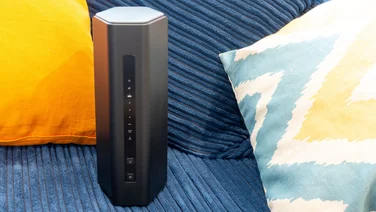To help us provide you with free impartial advice, we may earn a commission if you buy through links on our site. Learn more






- Flexible configuration
- Good coverage and speed
- High price
- Not as fast as BT Whole Home Wi-Fi
It seems you can’t move for whole-home Wi-Fi systems at the moment, with the Linksys Velop following hot on the heels of the Netgear Orbi and BT Whole Home Wi-Fi. Just like its recent forebears, the Velop is a “mesh” Wi-Fi setup designed to extend a blanket of strong wireless coverage across the whole of your home.
It comes in the form of three “nodes” that shuttle the wireless signal between them, amplifying it at each stage in order to ensure faster throughput over a larger area than a standard single router.
READ NEXT: Best wireless routers
Linksys Velop review: Price and competition
The Velop is nothing if not flexible. It’s possible to buy the Velop in one of three configurations: a single device, a twin pack or a triple pack. The single device is intended as an upgrade for existing networks, giving you a quick way to extend a wireless network further, but it’s an expensive way to do that.
This gives you more flexibility than either Orbi, which is only available as a twin pack or Whole Home Wi-Fi, which is only available as a triple pack. However, the price is a little hard to stomach, with a single device costing a whopping £200, two costing £350 and three costing £500. That’s far too expensive especially as Orbi is £371 and the BT system is £300.
Linksys Velop review: Design, features and initial setup
Linksys has done a nice job with the satellite’s design, though. The tall columns are easy to place around your home and their unobtrusive finish means that they’ll blend neatly into the background.
Set into the base of each satellite are two Gigabit Ethernet ports and the power input, plus a cable clip at the back that helps you keep cables out of the way. The first device that you connect needs to be plugged into your existing router or modem via Ethernet. Subsequent satellites don’t need connecting at all, although you can use the Ethernet ports for connecting wired devices such.






Setting the system up is pretty easy, but you can’t do it via a laptop or PC. Linksys forces you to use the mobile app, available on Android and iOS. This takes you through the entire system configuration, starting by asking if you want to replace your existing router or connect Velop to an existing network. Once you’ve chosen, neat on-screen instructions take you through connecting the first device to your network and setting the Wi-Fi network name and password.
After that, the app helps you position the satellites around your home. Ideal placement is to go half-way between an existing satellite and the area you want coverage in. The app helps you with locating a new satellite, automatically checking the network connection, then giving you advice on whether you should move it or not.
This isn’t the quickest process, however, and takes considerably longer than it does with BT Whole Home Wi-Fi. The single LED on top of the router gives you a visual indication of signal strength, however, which is useful in diagnosing problems with the signal.
I configured my Velop system to connect to an existing router, but there’s a problem with doing this. Velop insists on dishing out IP addresses and still uses the primary wired device as a router. This means you end up with two networks, which can make handling port forwarding and other advanced features more difficult. With the BT Whole Home Wi-Fi, network settings and IP addresses are still handled by your main router, which makes a lot more sense.






To make matters worse, there’s no way of changing the way that Velop works and, in fact, the system doesn’t even give you control over the DHCP settings. The only option you have is to tell the Velop to reserve an IP address for a device, which is handy where you want a static address for a device such as a NAS.
It’s good to have a guest network built in, though, so you can give visitors restricted access to the internet without having to dish out your main wireless password.
And, in a first for wireless routers, the Velop has Amazon Alexa integration. Using the Velop’s Skill, you can use your Echo to ask Alexa for the guest network name and credentials, and the main network’s name. It’s a fun little feature, although a rather frivolous one.
Linksys Velop review: Performance
The Linksys employs tri-band 802.11ac Wi-Fi with the Velop, with two 867Mbits/sec 5GHz networks and one 400Mbits/sec 2.4GHz network. With multiple 5GHz networks, there should be more bandwidth available for the backbone used to connect the mesh network.
There’s no way to choose which network to join as Linksys uses band steering to direct connecting devices to the most appropriate network, based on signal strength and capability. It makes sense: these types of products are about delivering the best, most reliable wireless experience with no hassle or user intervention.






For comparison, I set up the three Linksys nodes in the same way as I did the BT system, hooking up the primary node to one of my Sky Q Hub’s two Gigabit Ethernet ports. Setup took around half-an-hour, and once I’d finished I ran a signal strength survey and two throughput tests to test speed and range around the house.
As with all of the whole home wireless kits we’ve tested, I found that consistent coverage across all areas of my house was excellent, with no dead or weak spots anywhere. Whether I was in the far reaches of my kitchen extension or even the garden I was able to get a usable, speedy connection to the internet.
With my main router sitting in the first-floor bedroom, that would be impossible with a single router, no matter how powerful. You can see how strong the signal is by looking at the signal strength graphic above. With one node positioned in the first-floor master bedroom, the second in the first-floor hall and the third downstairs in the kitchen extension, there isn’t a weak spot anywhere. (Weak areas are signified by the colour blue, green is acceptable, with the signal getting stronger as you go through yellow, orange and red.)

In our throughput tests, however, I found that the Linksys Velop lagged somewhat behind BT Whole Home Wi-Fi. Testing with a 15in MacBook Pro equipped with a 3×3 MIMO stream adapter chip, the Velop averaged 50MB/sec up close, and 27MB/sec in the kitchen, with the laptop sat two metres from the node at the end of the chain.
The BT Whole Home Wi-Fi system’s performance outshone that significantly, reaching 89MB/sec up close and 36MB/sec in the kitchen. I’ve also included figures from the Sky Q mesh network below, as well as the BT Smart Hub.

Linksys Velop review: Verdict
Ultimately, it’s this performance and the high price that make the Velop a less tempting purchase than its competitors. If you can get by with two access points and want to replace your existing router, the Netgear Orbi has more features and better performance and is cheaper.
If you want faster coverage in more places or can’t replace your existing router, then the BT Whole Home Wi-Fi is better value, integrates better with existing networks and had superior speeds in our tests.
| Hardware | |
|---|---|
| Modem | None |
| Wi-Fi Standard | 802.11ac |
| Bands | 2.4GHz, 5GHz |
| Stated speed | 866Mbits/sec (5GHz) x 2, 400Mbits/sec (2.4GHz) |
| USB ports | None |
| Wall mountable | No |
| Warranty | 3yr RTB |
| Details | www.linksys.com/gb |
| Part code | WHW0303-UK |







